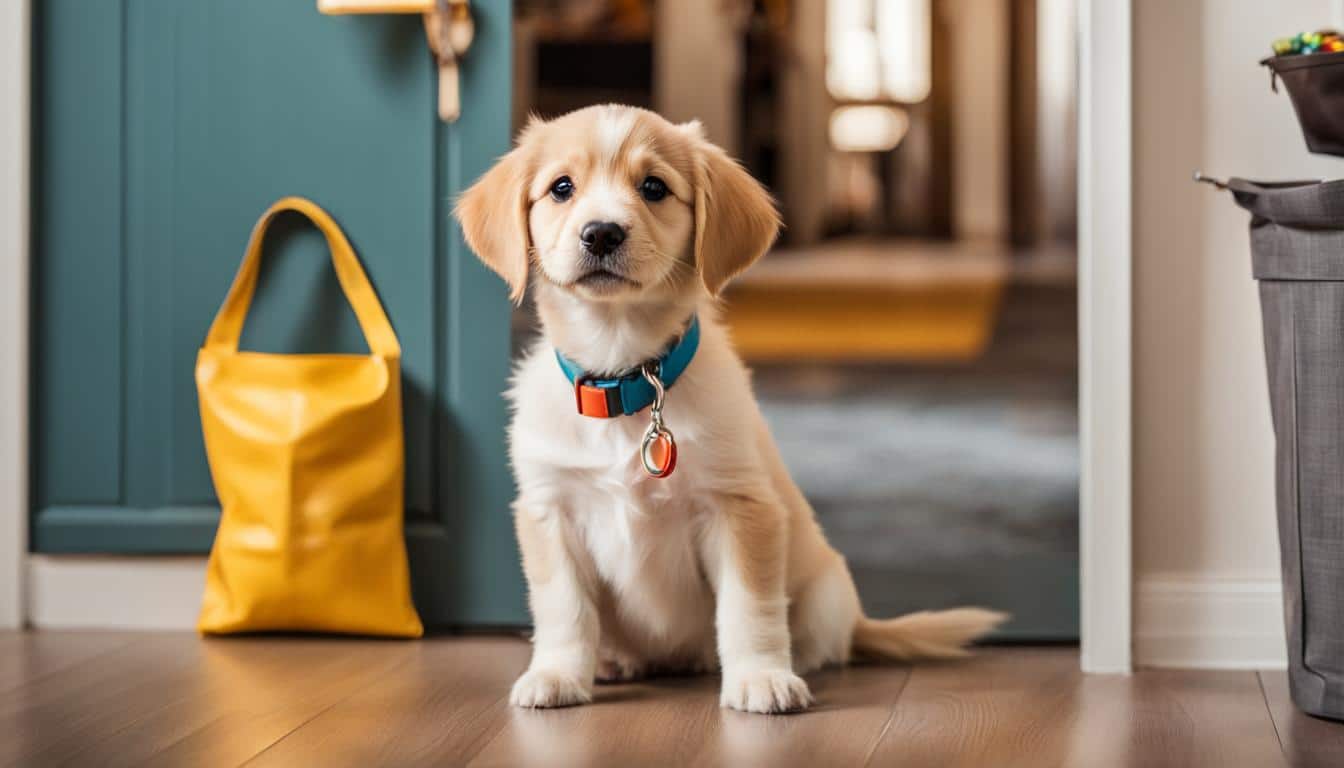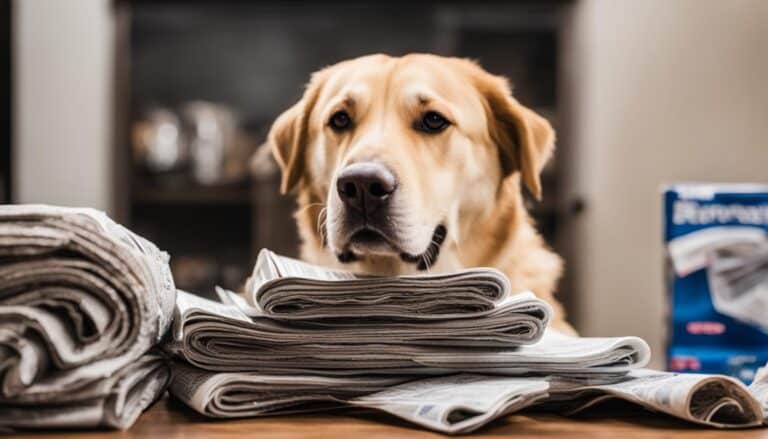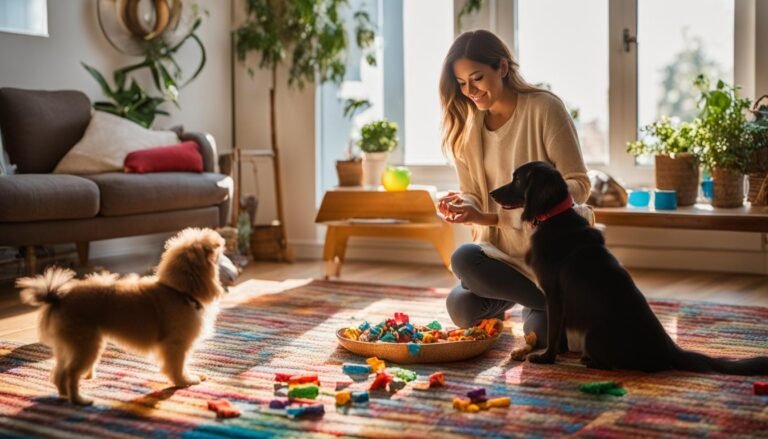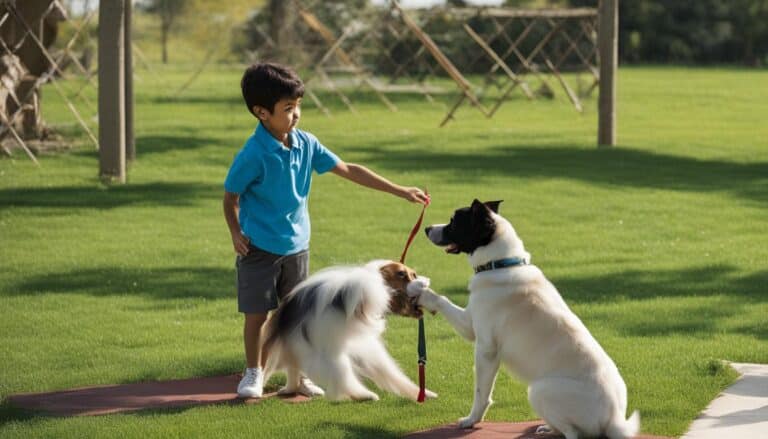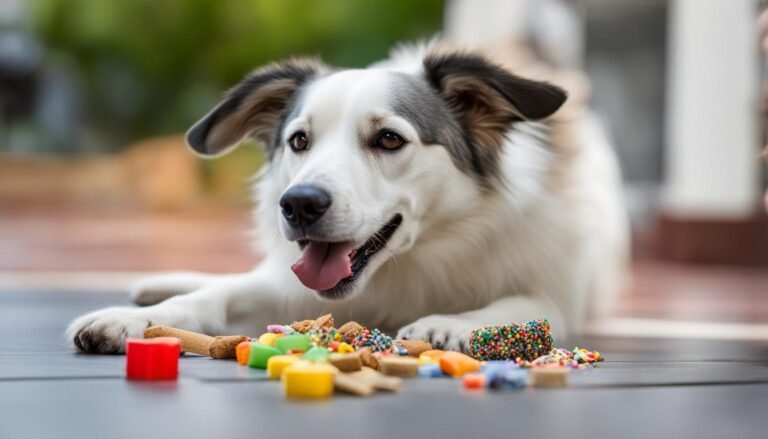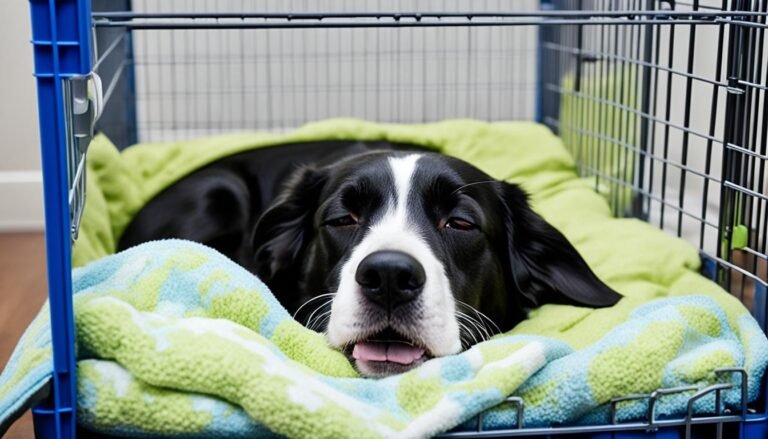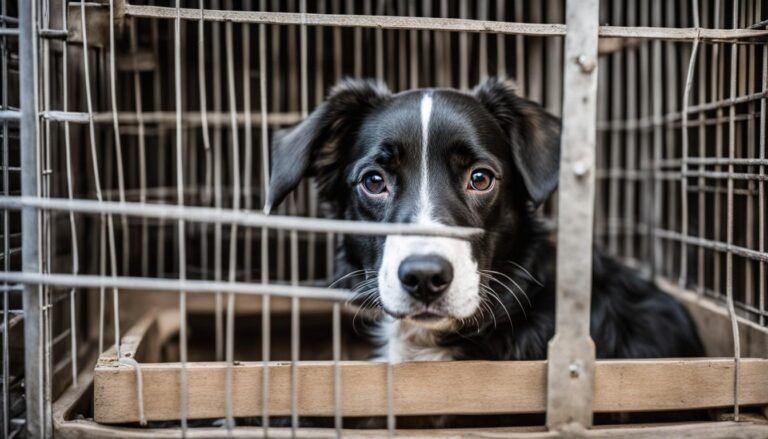How to House Train Dogs
Welcome to our guide on how to house train dogs! Whether you’re bringing home a new puppy or need to housebreak an adult dog, we’re here to help you with effective dog training methods. House training, also known as housebreaking or potty training, is an essential process when introducing a dog to your home.
Housebreaking a dog requires patience, commitment, and consistency. By following these tips for training dogs indoors, you can establish a routine and minimize accidents. We’ll cover everything from crate training for dogs to creating a potty training schedule that suits your dog’s needs.
Establishing a Routine
Puppies thrive on a regular schedule. By creating a routine, you teach them when it’s time to eat, play, and go to the bathroom. The general guideline is that a puppy can control their bladder for approximately one hour for every month of age. For example, a 2-month-old puppy can typically hold it for about two hours.
To establish a routine, it’s essential to take your puppy outside frequently, at least every two hours. Additionally, make sure to take them out after they wake up, play, or eat. This consistent schedule helps your puppy understand when it’s time to do their business and prevents accidents in the house.
When creating a routine, consider the following:
- Times to Eat: Feed your puppy at regular times throughout the day. This helps regulate their digestive system and makes it easier to predict when they’ll need to go.
- Times to Play: Set aside dedicated playtime for your puppy. This helps them burn off energy and promotes a healthy lifestyle.
- Taking Bathroom Breaks: Take your puppy outside every few hours, as well as after waking up, playing, or eating. This provides them with regular opportunities to eliminate outdoors.
By establishing a routine, you not only create a structured environment for your puppy but also set them up for success in their house training journey.
When establishing a routine for your puppy, consistency is key. Stick to the same feeding times, playtimes, and bathroom breaks every day. This helps your puppy understand what’s expected of them and reduces the likelihood of accidents in the house.
Taking Your Puppy Outside Frequently
When house training your puppy, one of the most important aspects is taking them outside frequently. This helps them develop good bathroom habits and minimizes accidents in the house. Here are some key tips for taking your puppy outside:
1. Bathroom Breaks
Take your puppy outside every two hours to give them a chance to relieve themselves. It’s also essential to take them outside immediately after they wake up, play, or eat. By doing so, you’ll prevent accidents and reinforce the behavior of going outside to eliminate.
2. Specific Bathroom Spot
Designate a specific area in your yard or outside your home where you want your puppy to go to the bathroom. When you take them outside, lead them to this spot consistently. This helps them establish a connection between the spot and the act of elimination.
3. Leash Training
While outside, use a leash to keep your puppy close to you and prevent them from wandering off. Leash training also helps them associate going outside with the bathroom routine. Gradually, you can give them more freedom once they understand where they should go.
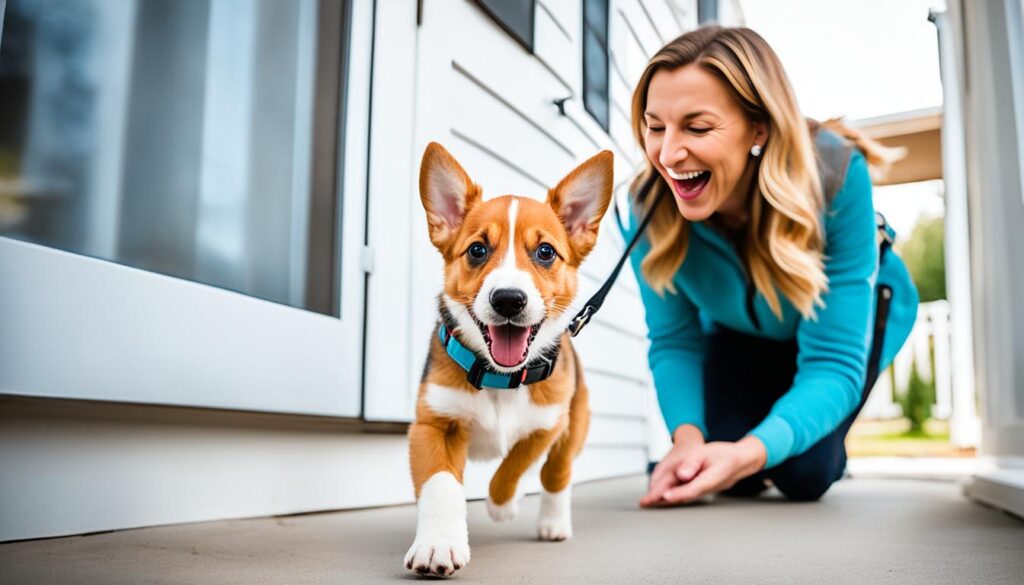
4. Use of Specific Word or Phrase
While your puppy is eliminating, consistently use a specific word or phrase that you want to associate with this behavior. This can be as simple as saying “Go potty” or “Do your business.” Over time, they will learn to associate that word or phrase with the act of going to the bathroom outside.
5. Longer Walks or Playtime after Elimination
After your puppy has finished eliminating outside, reward them with praise, treats, or even a longer walk or playtime. This creates a positive association with the act of eliminating and reinforces their good behavior.
By taking your puppy outside frequently and following these tips, you’ll establish a strong foundation for successful house training. Remember to be patient, consistent, and always praise and reward their efforts!
Putting Your Puppy on a Regular Feeding Schedule
Establishing a regular feeding schedule is essential for house training. Puppies should be fed at the same times every day, depending on their age. Generally, puppies may need to be fed two or three times a day. By feeding your puppy at consistent times, you can predict when they will need to eliminate and make house training easier. It’s also important to pick up your puppy’s water dish about two and a half hours before bedtime to minimize bathroom breaks during the night.
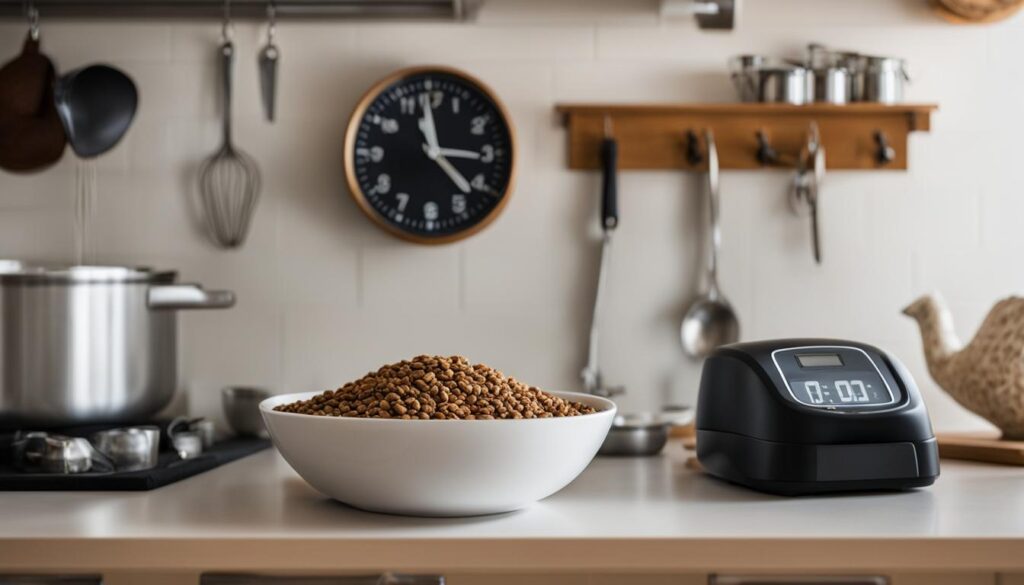
Rewarding Your Puppy for Eliminating Outdoors
Rewarding your puppy is a key component of successful house training. When your puppy eliminates outdoors, make sure to provide immediate praise and rewards. This timing is crucial for reinforcing the desired behavior and helping your puppy understand what is expected of them. It’s essential to reward your puppy while they are still outside near the elimination spot, not after they come back inside. By consistently rewarding your puppy for going to the bathroom outside, you encourage them to continue eliminating in the appropriate place.
One effective way to reward your puppy is through praise. Use a cheerful and enthusiastic tone of voice to let them know they have done a good job. You can also use treats as rewards, but make sure to choose small, easily digestible ones that your puppy loves. Keep the treats handy so that you can quickly give them to your puppy as soon as they finish eliminating outdoors.
Timing is crucial when rewarding your puppy. Make sure to deliver the praise or treat immediately after they finish eliminating. This helps to reinforce the behavior and create a positive association between going to the bathroom outside and receiving a reward. Remember to reward your puppy while they are still outside so that they understand that the reward is for eliminating in the appropriate spot.
Consistency is key when it comes to rewarding your puppy. Make sure to reward them every time they eliminate outdoors, even if it’s just a small amount. This helps to reinforce the desired behavior and motivate your puppy to continue eliminating outside. As your puppy becomes more reliable in their house training, you can gradually decrease the frequency of rewards but continue to provide praise and encouragement.
By rewarding your puppy for eliminating outdoors, you establish positive reinforcement for the desired behavior. This helps your puppy understand what you expect from them and reinforces the habit of going to the bathroom outside. With consistent rewards, praise, and timing, your puppy will learn to associate eliminating outdoors with positive experiences and will become fully house trained.
Crate Training for Dogs
Crate training can be a valuable tool for house training dogs, providing them with a safe and comfortable space. Dogs have a natural instinct to seek out den-like environments, and a crate can fulfill this need while also aiding in house training. When used correctly, crate training can have numerous benefits for both you and your furry friend.
- Crate Size: One important aspect of crate training is choosing the right crate size. It should be large enough for your dog to stand, lie down, and turn around comfortably. A crate that is too small can be uncomfortable and restrictive for your dog, while one that is too large may allow them to eliminate in one corner and sleep in another. Consider the adult size of your dog when selecting a crate and choose a size that will accommodate their growth.
- Potty Training: The crate can be a useful tool for potty training your dog. Dogs naturally prefer to keep their sleeping area clean, so their instinct will be to avoid eliminating in the crate. When your dog shows signs of restlessness or whining, it usually means they need to go outside to eliminate. Take them immediately to their designated bathroom spot and reward them after they’ve finished. This reinforces the behavior of eliminating outside and helps them associate positive experiences with going in the right place.
- Preventing Accidents: Another benefit of crate training is that it can prevent accidents in the house when you are unable to supervise your dog. Dogs should never be left in their crate for extended periods of time without bathroom breaks, but when you need to leave the house or cannot monitor your dog closely, the crate provides a safe and secure space where accidents are less likely to occur.
Remember that crate training should always be done positively and gradually. Introduce your dog to the crate in a calm and reassuring manner, using treats and praise to create a positive association. Avoid using the crate as a form of punishment, as it should be a place where your dog feels safe and comfortable.
By incorporating crate training into your house training routine, you can help your dog learn proper elimination habits and create a harmonious living environment. The crate serves as a tool for both potty training and preventing accidents in the house when used correctly.
Puppy Pads and Paper Training
Puppy pads and paper training can provide alternative options for house training dogs, particularly in circumstances where going outside frequently is challenging. Whether it’s due to inclement weather or extended periods away from home, having indoor potty spots can be convenient for both you and your puppy. By designating a specific area indoors for your puppy to eliminate, you can help maintain a clean and controlled environment.
When using puppy pads or paper training, it’s important to recognize that it introduces two different options for your puppy—indoors and outdoors. This can sometimes hinder the overall house training process, as it may create confusion for your furry friend. However, if you choose to incorporate this method, you can gradually transition your puppy to eliminate outside all the time as they mature.
It’s essential to remember that puppy pads and paper training should be used as temporary measures and not as a long-term solution. The ultimate goal of house training is to teach your puppy to eliminate outside consistently. When they are ready, encourage outdoor elimination by slowly reducing the use of indoor potty spots. With patience, consistency, and positive reinforcement, your puppy can learn to become fully house trained.
Alternative Options for House Training
If puppy pads and paper training aren’t the right fit for your situation, there are other alternative options for house training that you can explore:
- Indoor Turf Potty: Similar to puppy pads, indoor turf potties provide a designated area indoors for your puppy to eliminate. These artificial grass patches mimic the feel and scent of real outdoor grass, making it an attractive option for dogs.
- Dog Litter Boxes: Designed specifically for dogs, litter boxes are another alternative for indoor elimination. These boxes typically contain absorbent materials such as paper pellets or grass-like turf that help control odor.
- Bell Training: Bell training involves teaching your puppy to signal their need to go outside by pawing or ringing a bell attached to the doorknob. This method can be effective in reinforcing the association between ringing the bell and going potty outdoors.
It’s important to consider your lifestyle, living situation, and your puppy’s specific needs when choosing the right house training method. Remember that consistency is key, regardless of the approach you take. By providing clear expectations, positive reinforcement, and plenty of patience, you can successfully house train your puppy and establish good potty habits.
Overcoming House Training Challenges
Even when you follow all the proper house training techniques, it’s not uncommon for dogs to still have accidents or struggle with the process. If you’re facing house training problems, it’s essential to consider any physical issues that could be contributing to the problem. Urinary or gastrointestinal problems, for example, may cause your dog to have difficulty controlling their elimination.
To address these challenges, it’s recommended to consult with a veterinarian for a thorough examination of your dog. The veterinarian can assess bladder and bowel control and provide guidance on any necessary treatments or adjustments to your dog’s diet. By identifying and addressing any underlying physical issues, you can help improve your dog’s house training success.
In some cases, seeking professional help from a certified trainer or behaviorist experienced in house training challenges can be beneficial. These professionals can help address specific issues your dog may be facing and develop a tailored training plan that works best for your dog’s needs. With their expertise, you can overcome house training difficulties and create a positive and successful training experience for both you and your furry friend.
